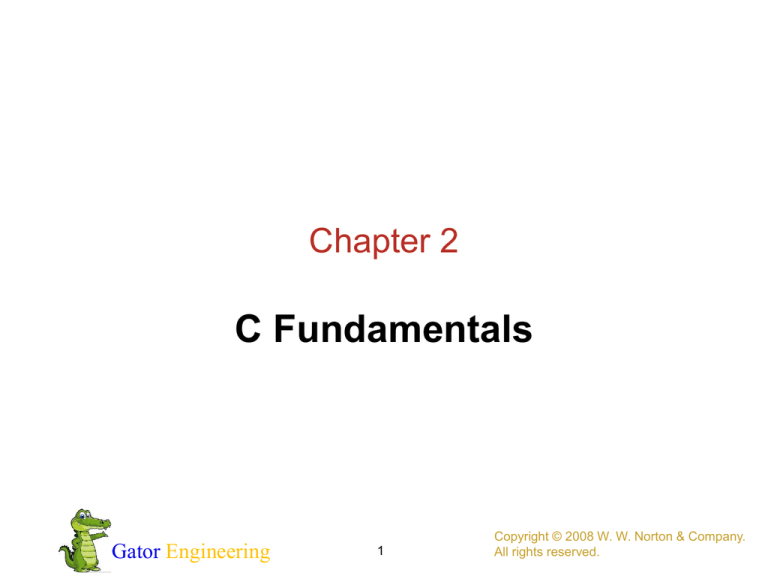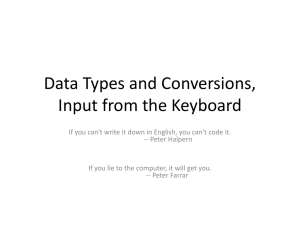
Chapter 2
C Fundamentals
Gator Engineering
1
Copyright © 2008 W. W. Norton & Company.
All rights reserved.
Program: Printing HelloWorld
#include <stdio.h>
int main(void)
{
printf(“Hello World!\n");
return 0;
}
• The file name doesn’t matter, but the .c extension is
often required.
Gator Engineering
2
A few notes
• gcc environment
• To compile and run the code, you have to be in the
same folder where you have put the code
• A few most frequently used commands:
–
–
–
–
–
cd [folderName]
cd ..
ls (dir in windows)
pwd
“tab”
Gator Engineering
3
Compiling and Linking
• Before a program can be executed, three steps are
usually necessary:
– Preprocessing. The preprocessor obeys commands that
begin with # (known as directives)
– Compiling. A compiler translates then translates the
program into machine instructions (object code).
– Linking. A linker combines the object code produced
by the compiler with any additional code needed to
yield a complete executable program.
• The preprocessor is usually integrated with the
compiler.
Gator Engineering
4
The GCC Compiler
• GCC is one of the most popular C compilers.
• GCC is supplied with Linux but is available for
many other platforms as well.
• Using this compiler is similar to using cc:
% gcc -o SayHi HelloWorld.c
Gator Engineering
5
Integrated Development Environments
• An integrated development environment (IDE) is
a software package that makes it possible to edit,
compile, link, execute, and debug a program
without leaving the environment.
–
–
–
–
–
–
Visual C++ (Windows)
Visual Studio (Windows)
Xcode (Mac)
Eclipse (Cross-platforms)
Netbeans
CodeBlocks, etc.
Gator Engineering
6
The General Form of a Simple Program
• Simple C programs have the form
directives
int main(void)
{
statements
}
Gator Engineering
7
The General Form of a Simple Program
• C uses { and } in much the same way that some
other languages use words like begin and end.
• Even the simplest C programs rely on three key
language features:
– Directives
– Functions
– Statements
Gator Engineering
8
Directives
• Before a C program is compiled, it is first edited
by a preprocessor.
• Commands intended for the preprocessor are
called directives.
• Example:
#include <stdio.h>
• <stdio.h> is a header containing information
about C’s standard I/O library.
Gator Engineering
9
Directives
• Directives always begin with a # character.
• By default, directives are one line long; there’s no
semicolon or other special marker at the end.
Gator Engineering
10
Functions
• A function is a series of statements that have been
grouped together and given a name.
• Library functions are provided as part of the C
implementation.
• A function that computes a value uses a return
statement to specify what value it “returns”:
return x + 1;
Gator Engineering
11
The main Function
• The main function is mandatory.
• main is special: it gets called automatically when
the program is executed.
• main returns a status code; the value 0 indicates
normal program termination.
• If there’s no return statement at the end of the
main function, many compilers will produce a
warning message.
Gator Engineering
12
Statements
• A statement is a command to be executed when
the program runs.
• HelloWorld.c uses only two kinds of
statements. One is the return statement; the
other is the function call.
• Asking a function to perform its assigned task is
known as calling the function.
• HelloWorld.c calls printf to display a
string:
printf(“Hello World!\n");
Gator Engineering
13
Statements
• C requires that each statement end with a
semicolon.
– There’s one exception: the compound statement.
• Directives are normally one line long, and they
don’t end with a semicolon.
Gator Engineering
14
Printing Strings
• When the printf function displays a string
literal—characters enclosed in double quotation
marks—it doesn’t show the quotation marks.
• printf doesn’t automatically advance to the
next output line when it finishes printing.
• To make printf advance one line, include \n
(the new-line character) in the string to be
printed.
Gator Engineering
15
Printing Strings
• The statement
printf("To C, or not to C: that is the question.\n");
could be replaced by two calls of printf:
printf("To C, or not to C: ");
printf("that is the question.\n");
• The new-line character can appear more than once in a
string literal:
printf("Brevity is the soul of wit.\n
Gator Engineering
16
--Shakespeare\n");
Comments
• A comment begins with /* and end with */.
/* This is a comment */
• Comments may appear almost anywhere in a
program, either on separate lines or on the same
lines as other program text.
• Comments may extend over more than one line.
/* Name: HelloWorld.c
Purpose: Prints a greeting message.
Author: XXX */
Gator Engineering
17
Comments
• Warning: Forgetting to terminate a comment may cause
the compiler to ignore part of your program:
printf("My ");
printf("cat ");
printf("has ");
printf("fleas");
Gator Engineering
/* forgot to close this comment...
/* so it ends here */
18
Comments in C99
• In C99, comments can also be written in the
following way:
// This is a comment
• This style of comment ends automatically at the
end of a line.
• Advantages of // comments:
– Safer: there’s no chance that an unterminated comment
will accidentally consume part of a program.
– Multiline comments stand out better.
Gator Engineering
19
Variables and Assignment
• Most programs need to a way to store data
temporarily during program execution.
• These storage locations are called variables.
Gator Engineering
20
Types
• Every variable must have a type.
• C has a wide variety of types, including int and
float.
• A variable of type int (short for integer) can
store a whole number such as 0, 1, 392, or –2553.
– The largest int value is typically 2,147,483,647 but
can be as small as 32,767.
Gator Engineering
21
Types
• A variable of type float (short for floatingpoint) can store much larger numbers than an int
variable.
• Also, a float variable can store numbers with
digits after the decimal point, like 379.125.
• Drawbacks of float variables:
– Slower arithmetic
– Approximate nature of float values
Gator Engineering
22
Declarations
• Variables must be declared before they are used.
• Variables can be declared one at a time:
int height;
float profit;
• Alternatively, several can be declared at the same
time:
int height, length, width, volume;
float profit, loss;
Gator Engineering
23
Declarations
• When main contains declarations, these must
precede statements:
int main(void)
{
declarations
statements
}
Gator Engineering
24
Assignment
• A variable can be given a value by means of
assignment:
height = 8;
The number 8 is said to be a constant.
• Before a variable can be assigned a value—or
used in any other way—it must first be declared.
Gator Engineering
25
Assignment
• A constant assigned to a float variable usually
contains a decimal point:
profit = 2150.48;
Gator Engineering
26
Assignment
• An int variable is normally assigned a value of
type int, and a float variable is normally
assigned a value of type float.
• Mixing types (such as assigning an int value to a
float variable or assigning a float value to an
int variable) is possible but not always safe.
Gator Engineering
27
Assignment
• Once a variable has been assigned a value, it can
be used to help compute the value of another
variable:
height = 8;
length = 12;
width = 10;
volume = height * length * width;
/* volume is now 960 */
• The right side of an assignment can be a formula
(or expression, in C terminology) involving
constants, variables, and operators.
Gator Engineering
28
Printing the Value of a Variable
• printf can be used to display the current value
of a variable.
• To write the message
Height: h
where h is the current value of the height
variable, we’d use the following call of printf:
printf("Height: %d\n", height);
• %d is a placeholder indicating where the value of
height is to be filled in.
Gator Engineering
29
Printing the Value of a Variable
• %d works only for int variables; to print a
float variable, use %f instead.
• By default, %f displays a number with six digits
after the decimal point.
• To force %f to display p digits after the decimal
point, put .p between % and f.
• To print the line
Profit: $2150.48
use the following call of printf:
printf("Profit: $%.2f\n", profit);
Gator Engineering
30
Printing the Value of a Variable
• There’s no limit to the number of variables that can
be printed by a single call of printf:
printf("Height: %d
Gator Engineering
Length: %d\n", height, length);
31











